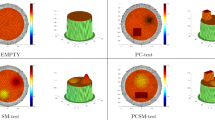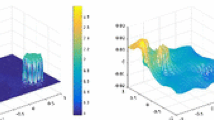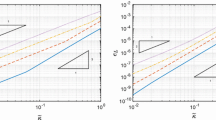Abstract
The inverse problem of electrical impedance tomography is severely ill-posed, meaning that, only limited information about the conductivity can in practice be recovered from boundary measurements of electric current and voltage. Recently it was shown that a simple monotonicity property of the related Neumann-to-Dirichlet map can be used to characterize shapes of inhomogeneities in a known background conductivity. In this paper we formulate a monotonicity-based shape reconstruction scheme that applies to approximative measurement models, and regularizes against noise and modelling error. We demonstrate that for admissible choices of regularization parameters the inhomogeneities are detected, and under reasonable assumptions, asymptotically exactly characterized. Moreover, we rigorously associate this result with the complete electrode model, and describe how a computationally cheap monotonicity-based reconstruction algorithm can be implemented. Numerical reconstructions from both simulated and real-life measurement data are presented.





Similar content being viewed by others
Notes
The former in the sense in which \(\mathbb {R}^k\) is identified with the subspace of \(L^2(\partial \varOmega )\) consisting of piecewise constant functions of form \(a = \sum _j a_j\chi _j\) where \(\chi _j\) is the characteristic function of \(E_j\).
References
Astala, K., Päivärinta, L.: Calderón’s inverse conductivity problem in the plane. Ann. Math. 163(1), 265–299 (2006)
Bebendorf, M.: A note on the Poincaré inequality for convex domains. Z. Anal. Anwendungen. 22(4),751–756 (2003)
Borcea, L.: Electrical impedance tomography. Inverse Probl. 18, 99–136 (2002)
Brühl, M.: Explicit characterization of inclusions in electrical impedance tomography. SIAM J. Math. Anal. 32, 1327–1341 (2001)
Brühl, M., Hanke, M.: Numerical implementation of two non-iterative methods for locating inclusions by impedance tomography. Inverse Probl. 16, 1029–1042 (2000)
Calderón, A.P.: On an inverse boundary value problem. In: Seminar on Numerical Analysis and its Applications to Continuum Physics (Rio de Janeiro, 1980), pp. 65–73. Sociedade Brasileira de Matemática, Rio de Janeiro (1980)
Cheney, M., Isaacson, D., Newell, J., Simske, S., Goble, J.: Noser: an algorithm for solving the inverse conductivity problem. Int. J. Imaging Syst. Technol. 2(2), 66–75 (1990)
Cheney, M., Isaacson, D., Newell, J.C.: Electrical impedance tomography. SIAM Rev. 41(1), 85–101 (1999)
Cheng, K., Isaacson, D., Newell, J., Gisser, D.: Electrode models for electric current computed tomography. IEEE Trans. Biomed. Eng. 36(9), 918–924 (1989)
Chung, E.T., Chan, T.F., Tai, X.C.: Electrical impedance tomography using level set representation and total variation regularization. J. Comput. Phys. 205(1), 357–372 (2005)
Gebauer, B.: Localized potentials in electrical impedance tomography. Inverse Probl. Imaging 2(2), 251–269 (2008)
Hanke, M., Brühl, M.: Recent progress in electrical impedance tomography. Inverse Probl. 19(6), S65–S90 (2003) (Special section on imaging)
Hanke-Bourgeois, M., Kirsch, A.: Sampling methods. In: Handbook of Mathematical Methods in Imaging, pp. 591–647. Springer, New York (2015)
Harrach, B.: Recent progress on the factorization method for electrical impedance tomography. Comput. Math. Methods Med. 2013 (2013) http://dx.doi.org/10.1155/2013/425184
Harrach, B.: Interpolation of missing electrode data in electrical impedance tomography. Inverse Probl. 31(11), 115,008 (2015)
Harrach, B., Lee, E., Ullrich, M.: Combining frequency-difference and ultrasound modulated electrical impedance tomography. Inverse Probl. 31(9), 095,003 (2015)
Harrach, B., Seo, J.K.: Detecting inclusions in electrical impedance tomography without reference measurements. SIAM J. Appl. Math. 69(6), 1662–1681 (2009)
Harrach, B., Seo, J.K.: Exact shape-reconstruction by one-step linearization in electrical impedance tomography. SIAM J. Math. Anal. 42(4), 1505–1518 (2010)
Harrach, B., Ullrich, M.: Monotonicity-based shape reconstruction in electrical impedance tomography. SIAM J. Math. Anal. 45(6), 3382–3403 (2013)
Harrach, B., Ullrich, M.: Resolution guarantees in electrical impedance tomography. IEEE Trans. Med. Imaging 34(7), 1513–1521 (2015)
Heikkinen, L.M., Vilhunen, T., West, R.M., Vauhkonen, M.: Simultaneous reconstruction of electrode contact impedances and internal electrical properties: II. Laboratory experiments. Meas. Sci. Technol. 13, 1855–1861 (2002)
Hyvönen, N.: Complete electrode model of electrical impedance tomography: approximation properties and characterization of inclusions. SIAM J. Appl. Math. 64(3), 902–931 (2004)
Hyvönen, N.: Approximating idealized boundary data of electric impedance tomography by electrode measurements. Math. Models Methods Appl. Sci. 19(7), 1185–1202 (2009)
Hyvönen, N., Karhunen, K., Seppänen, A.: Fréchet derivative with respect to the shape of an internal electrode in electrical impedance tomography. SIAM J. Appl. Math. 70(6), 1878–1898 (2010)
Hyvönen, N., Seppänen, A., Staboulis, S.: Optimizing electrode positions in electrical impedance tomography. SIAM J. Appl. Math. 74(6), 1831–1851 (2014)
Ikehata, M.: How to draw a picture of an unknown inclusion from boundary measurements. Two mathematical inversion algorithms. J Inverse Ill Posed Probl. 7(3), 255–271 (1999)
Ikehata, M.: Reconstruction of the support function for inclusion from boundary measurements. J. Inverse Ill Posed Probl. 8, 367–378 (2000)
Kaipio, J., Kolehmainen, V., Somersalo, E., Vauhkonen, M.: Statistical inversion and monte carlo sampling methods in electrical impedance tomography. Inverse Probl. 16(5), 1487–1522 (2000)
Kato, T.: Perturbation theory for linear operators, vol. 132. Springer, Berlin (1995)
Lechleiter, A.: A regularization technique for the factorization method. Inverse Probl. 22, 1605 (2006)
Lechleiter, A., Hyvönen, N., Hakula, H.: The factorization method applied to the complete electrode model of impedance tomography. SIAM J. Appl. Math. 68, 1097–1121 (2008)
Lechleiter, A., Rieder, A.: Newton regularizations for impedance tomography: convergence by local injectivity. Inverse Probl. 24, 065,009 (2008)
Lieb, E.H., Seiringer, R., Yngvason, J.: Poincaré inequalities in punctured domains. Ann. Math. 158, 1067–1080 (2003)
Lions, J.L., Magenes, E.: Non-homogeneous boundary value problems and applications, vol. 1. Springer, New York-Heidelberg (1972)
Nachman, A.I.: Global uniqueness for a two-dimensional inverse boundary value problem. Ann. Math. 143, 71–96 (1996)
Reed, M., Simon, B.: Methods of Modern Mathematical Physics. vol. I. Functional Analysis. Academic Press Inc., New York (1990)
Resnick, S.I.: A Probability Path. Birkhäuser, Boston (2014)
Somersalo, E., Cheney, M., Isaacson, D.: Existence and uniqueness for electrode models for electric current computed tomography. SIAM J. Appl. Math. 52(4), 1023–1040 (1992)
Sylvester, J., Uhlmann, G.: A global uniqueness theorem for an inverse boundary value problem. Ann. Math. 125, 153–169 (1987)
Tamburrino, A.: Monotonicity based imaging methods for elliptic and parabolic inverse problems. J. Inverse Ill Posed Probl. 14(6), 633–642 (2006)
Tamburrino, A., Rubinacci, G.: A new non-iterative inversion method for electrical resistance tomography. Inverse Probl. 18(6), 1809 (2002)
Uhlmann, G.: Electrical impedance tomography and Calderón’s problem. Inverse Probl. 25(12), 123,011 (2009)
Vauhkonen, M., Vadász, D., Karjalainen, P.A., Somersalo, E., Kaipio, J.P.: Tikhonov regularization and prior information in electrical impedance tomography. IEEE Trans. Med. Imaging 17, 285–293 (1998)
Acknowledgments
Henrik Garde is supported by advanced grant no. 291405 HD-Tomo from the European Research Council. Stratos Staboulis is supported by grant no. 4002-00123 Improved Impedance Tomography with Hybrid Data from The Danish Council for Independent Research | Natural Sciences. The authors are grateful to Professor Jari Kaipio’s research group at the University of Eastern Finland (Kuopio) for granting us access to their EIT devices. We thank Marcel Ullrich at University of Stuttgart for his valuable insight on the implementation details of the presented method.
Author information
Authors and Affiliations
Corresponding author
Appendices
Appendix A: A lemma on the convergence of infima/suprema
Lemma 2
Let J be an arbitrary index set and \(\{a_j\}_{j\in J}, \{a_j(h)\}_{j\in J} \subset \mathbb {R}\), \(h > 0\), be sequences such that \(\inf _{j\in J}a_j>-\infty \) and
Denoting \( a = \inf _{j\in J} a_j\) and \(a(h) = \inf _{j\in J} a_j(h)\) we have
Proof
Let us first show that the limit in (51) exists. Given an arbitrary \(\varepsilon > 0\), there exists an \(h_{\varepsilon } > 0\) such that \(\sup _{j\in J}|a_j - a_j(h)| \le \varepsilon /2\) for all \(h \in (0,h_{\varepsilon })\). Let \(h, h' \in (0,h_{\varepsilon })\) then \(\sup _{j\in J}|a_j(h)-a_j(h')|\le \varepsilon \), and fix a sequence \(\{j(k)\}_{k=1}^\infty \subseteq J\) such that \( a_{j(k)}(h)\) converges to a(h). Hence
By symmetry with respect to h and \(h'\), it follows that \(\{a(h)\}_{h>0}\) is a Cauchy sequence.
It still remains to show that the limit coincides with a. For any \(\varepsilon > 0\), there exists \(j_{\varepsilon }\in J\) and \(h_{\varepsilon } > 0\) such that \(|a_{j_{\varepsilon }} - a|\le \varepsilon /2\) and \(\sup _{j\in J}|a_j - a_j(h)| \le \varepsilon /2\) for \(h\in (0,h_{\varepsilon })\), respectively. Thus for \(h\in (0,h_{\varepsilon })\)
For \(h\in (0,h_{\varepsilon })\) pick \(j_{\varepsilon }'\) such that \(|a_{j_{\varepsilon }'}(h)-a(h)|\le \varepsilon /2\) then
Altogether we have shown for any \(\varepsilon > 0\) that \(|a(h) - a| \le \varepsilon \) for \(h\in (0,h_{\varepsilon })\). \(\square \)
Appendix B: Linearization of the CEM and the CM
Proposition 5
The operators \(\Lambda (\gamma ) \in \mathcal {L}(L_\diamond ^2(\partial \varOmega ))\) and \(R(\gamma )\in \mathcal {L}(\mathbb {R}_\diamond ^k)\) are analytic in \(\gamma \in L_+^\infty (\varOmega )\). In particular, they are infinitely many times Fréchet differentiable. Furthermore, if \(\eta \) is compactly supported in \(\varOmega \), then the boundary value problems
uniquely determine the Fréchet derivatives via
respectively. Above u and (v, V) are the unique weak solutions of (2) and (29), respectively.
Proof
For clarity, we only consider the CEM case as the CM can be handled analogously [6]. Given \((v,V)\in H^1(\varOmega )\oplus \mathbb {R}_\diamond ^k\) and \(\eta \in L_+^\infty (\varOmega )\), the variational problem
for all \((w,W)\in H^1(\varOmega ) \oplus \mathbb {R}_\diamond ^k\), is uniquely solvable. Moreover, if (v, V) weakly solves (29), then \(V' = (R'(\gamma )\eta )I\) [32]. Clearly, if \(\eta \) is compactly supported, the right-hand side of (54) does not induce any boundary terms and hence \((v',V')\) satisfies (53).
Define the mapping
as the solution operator to (54). Consider the expansion
where we denote \(V(\gamma ) = R(\gamma )I\) and \(V(\gamma +\eta ) = R(\gamma + \eta )I\). A direct calculation using the variational formulation with the associated internal potentials reveals
As \(\Vert D(\eta )\Vert \le C\Vert \eta \Vert _{L^\infty (\varOmega )}\), the associated Neumann-series converges for small enough \(\eta \). Consequently,
Different order Fréchet derivatives can be inductively derived using (55) and the fact that \(D(\eta )\) is linear. \(\square \)
Rights and permissions
About this article
Cite this article
Garde, H., Staboulis, S. Convergence and regularization for monotonicity-based shape reconstruction in electrical impedance tomography. Numer. Math. 135, 1221–1251 (2017). https://doi.org/10.1007/s00211-016-0830-1
Received:
Revised:
Published:
Issue Date:
DOI: https://doi.org/10.1007/s00211-016-0830-1
Keywords
- Electrical impedance tomography
- Inverse problems
- Monotonicity method
- Regularization
- Complete electrode model
- Direct reconstruction methods




